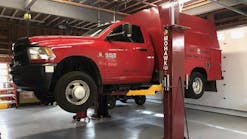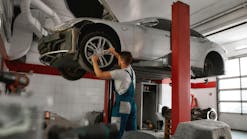AAPEX Seminar: Telematics presents the automotive aftermarket new challenges and opportunities
Telematics, a technology that enables sending, receiving and storing information via telecommunication devices in conjunction with affecting control on remote objects, has become more pervasive in new automobiles, posing both challenges and opportunities to the automotive aftermarket. In the interest of helping aftermarket companies better understand these challenges and opportunities, the recent Automotive Aftermarket Product Expo (AAPEX) in Las Vegas included a session devoted to this topic, titled: "Yes, the aftermarket can do telematics."
Telematics is designed to allow technicians to complete diagnoses and repairs faster and easier by accessing technical service bulletins, recall information, color wiring diagrams, component locations, vehicle specifications and repair procedures.
Introducing the seminar, which drew a large audience at the convention, were Scott Luckett, the Automotive Aftermarket Industry Association (AAIA) chief information officer, and Ben Johnson, director of product management at Mitchell 1 who serves as the chairman of the AAIA standards committee. Luckett noted that telematics pose both a threat and an opportunity to the relationship between the aftermarket industry and their customers, the car owners.
Luckett said 40 percent of a vehicle's economic value will be in its computer. He said 62 percent of new vehicles in 2016 will have factory-equipped telematics. He further noted that original equipment (OE) manufacturers view telematics as a way to direct post-warranty repair work to their dealers.
"The aftermarket is a bit of a bogeyman if we as an industry do nothing," Luckett said.
Johnson of Mitchell 1 confirmed Luckett's comments. "It (telematics) changes the way we begin service. What hasn't changed is the customer's expectation of service," Johnson said. "By the time that car shows up at the bay, we have a pretty good idea what might be wrong with it."
Johnson said telematics allows repair shops to proactively monitor a vehicle's condition. He noted that last year's AAPEX show included a "Shop of Tomorrow" exhibit that demonstrated how aftermarket workflow will be affected by telematics.
This year, AAPEX held a contest, the "aftermarket telematics challenge," as a way to identify companies that have seen the telematics vision and provided a telematics offering. As already reported by PTEN, Delphi Products & Service Solutions won the first AAIA aftermarket telematics challenge.
Malcolm Sissmore, telematics sales director for Delphi Products & Service Solutions, then took the podium. He noted that OnStar, the best known telematics provider, has already gained a big following among car owners. Sissmore said OnStar has a 70 percent close rate among new car owners, and there are already 66 million cars globally that have OnStar. "If 70 percent of those customers go back to the dealer (for aftermarket work), we're all in trouble," Sissmore said.
Sissmore then turned the floor over to Jim Dykstra, owner of Dysktra's Auto Service in Troy, Mich., who participated in a test of the Delphi telematics system. Dykstra has also developed a company to provide interfaces for Delphi's telematics called Aftermarket Telematics Technologies LLC.
As a telematics user, Dykstra said he was able to monitor car data remotely. He said telematics is moving the aftermarket service paradigm from point of sale to point of need, which is what he found customers want.
Telematics builds customer loyalty by providing a sense of security and convenience, Dykstra said. He said it creates a direct link between the shop technician and the car owner.
Dykstra noted he was able to communicate text messages to customers in their vehicles.
Telematics also allows each car owner to have a private portal on the Internet.
Telematics hold a lot of promise for vehicle fleet managers, Dykstra said. Big benefits to fleet operators include asset management and employee time management.
Seminar attendees had many questions for the speakers about telematics.
In responses to a question, Dykstra said telematics currently costs $150 for the hardware in a vehicle and $5 to $7 per month for air time. He said service shops can cover some of this cost. He noted that payment scenarios vary. "We don't want to tell the aftermarket how to slice it," he said.
Asked if the car can communicate directly to a parts supplier, Dykstra said telematics makes this possible.
Asked how much time it takes shop personnel to manage customer communications using telematics, Dykstra said the amount of employee time has not been great.
Asked if the costs will decline over time, Sissmore said it is more likely that costs will stay level but the information offering will increase.


